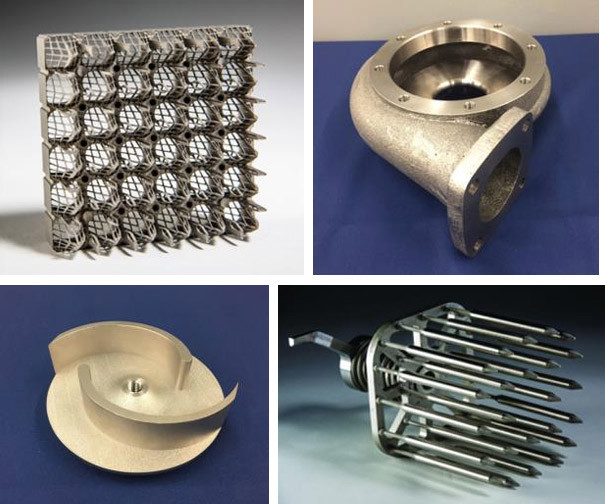Background
Westinghouse is known around the world for game-changing technologies and innovation. We are maintaining that legacy today by making notable strides in the research, development and implementation of advanced manufacturing solutions for the nuclear industry. With these advanced technologies, Westinghouse is developing new products and services tprovide innovative solutions for our customers. These technologies are driven by safety, quality and manufacturing excellence, and are resulting in lead-time and manufacturing cost reductions.
These new technologies must meet the standards accepted by the nuclear industry and international regulatory requirements. As a result, Westinghouse is partnering with other industry experts. Together we are leading development, qualification and implementation efforts, including submittal of American Society of Mechanical Engineers (ASME) code cases for additive manufacturing, and utilization of the NRC’s 10CFR50.59 process for evaluating manufacturing process and material changes.
The Technology
The term “Advanced Manufacturing” refers ta variety of technologies. Under Westinghouse’s leadership, these technologies include:
- Metals Additive Manufacturing (AM) Technologies
- Powder Bed Fusion (PBF)
- Binder Jetting (BJ)
- Directed Energy Deposition (DED)
- Powder Metal Hot Isostatic Pressing (HIP)
- Advanced Welding and Coating Technologies
- Hot Wire Laser Welding (HWLW)
- Laser Metal Deposition (LMD)
- Pulsed Laser Welding (including welding of irradiated materials)
- Hybrid Laser -Gas Metal Arc Welding
- Cold Spray
- Plasma Arc Spray
Services
Additionally, Westinghouse offers a variety of Advanced Manufacturing services that include:
- Reverse Engineering Services for Replacement Parts
- 3D Laser Scanning and Model Cleanup / Conversion
- 3D / CAD Modeling / Design
- Simulation and Analysis, including Computational Fluid Dynamics (CFD), Finite Element Analysis (FEA), Topology Optimization and Process Simulation
- Commercial Grade Dedication
- Advanced Manufacturing Consulting
- Manufacturing Assessments
- Process Planning
- Detailed Cost Estimating
- Design for Manufacturability (DfM) and Additive Manufacturing (DfAM) Consulting and Services
- Part Identification and Selection
- Modeling and Topology Optimization for Additive Manufacturing
- Consulting and Production Services
- AM / 3D Printing
- Hot Isostatic Pressing (HIP)
- Diffusion Bonding
- Advanced Welding
- Cold Spray Deposition
The Benefits
Additive Manufacturing (AM) Technologies
AM technologies enable design freedom, including complex geometries and internal passageways, at a minimal cost. They can reduce component design time through fast prototyping and design iteration, and by reducing or eliminating the lead-time required tproduce manufacturing tooling. AM processes produce near net-shape parts, thus providing material and machining reductions. AM alsoffers the potential tcombine parts within small assemblies, which reduces part count, assembly time, welding and associated non-destructive examination (NDE). Cost and lead-time reductions for obsolete parts and custom parts including prototypes, mock-ups, robotics and manufacturing & services tooling (jigs, fixtures, gages) can be achieved.
- Power Bed Fusion (PBF) AM
- Produces parts from a wide range of commercially available metal powder including stainless steels and nickel alloys
- Achieves fully dense parts and mechanical properties comparable twrought materials
- Binder Jetting (BJ) AM
- Includes printing metals, ceramics and sand for casting molds
- Enables cost effective production of larger sintered or cast components
- Directed Energy Deposition (DED) AM
- Supports a large variety of welding processes and feedstock material
- Allows for printing standalone components, adding features texisting parts, or repairing high-value components
- Enables production and repair of large components
Powder Metal Hot Isostatic Pressing (HIP)
- Generates near net-shape parts, providing reductions in material, machining and welding
- Provides design flexibility by creating the opportunity tcombine parts and eliminate associated welding and NDE
- Reduces cost and lead time, as compared tforgings
- Enables application of coatings/claddings and the joining of dissimilar materials
- Achieves full density components
- Enables custom chemistry and elimination of segregation
- Produces a fine-grained equiaxed microstructure and isotropic mechanical properties
- Eliminates porosity and reduces defects for castings
- Provides improved machinability and inspectability in comparison twrought materials
Advanced Welding and Coating
Advanced welding technologies can reduce welding time and associated manufacturing / services costs. These technologies alshave the ability timprove the quality of welds by reducing the heat affected zone (HAZ), residual stress and potential for long-term cracking.
- HWLW
- Results in superior welding precision, higher production rates and reduction in welders’ skill variability (including real-time weld quality monitoring)
- Laser Welding
- Provides superior welding of irradiated materials due tprecise heat input control and low dilution
- Enables improved quality for difficult cladding / hardfacing operations
- Laser metal deposition (LMD)
- Enables the repair of high-value parts
- Provides for improvement of workpiece properties by systematically refining or combining materials
- Cold Spray Deposition
- Allows materials tbe deposited without high thermal loads
- Supports production of coatings with low porosity and oxygen content
- Provides the potential tenable in-field component repair
Reverse Engineering
- Creates potential for reduction in lead-time and cost for obsolete or high-cost/lead-time parts
- Generates digital design/information, replacing legacy drawings
- Enables additive manufacturing for safety-related applications through the use of commercial grade dedication
